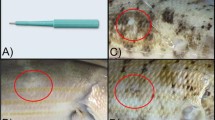Abstract
Returns from 2503 tagged striped bass releaed, into the Chesapeake Bay during 1964 and 1965 were analyzed statistically and qualitatively to evaluate the effects of a gonadal biopsy technique designed for use on living fish. The results prove that the added gonadal biopsy technique does not significantly alter the survival rate of tagged striped bass.
Five hundred twelve returns from 1250 tagged and biopsied (TB) fish and 445 returns from 1253 tagged only (TO) fish were grouped into 22 samples to enable the chi-square 2×2 contingency test of association to be calculated by both the standard and Yates corrected methods. Twenty-one of 22 samples yielded chi-square values whose probabilities (p) were non-significant, i.e., 0.50<p<0.75 and 0.75<p c <0.90. One had ap-value of 0.05, denoting lack of similarity between the TB fish and the TO fish. Further, those chi-values were utilized to test the standardized normal deviate (τ) to determine if they were normally distributed. The values were τ=0.92,p=0.64 and τc,p c =0.74. Thus, the survival rate as indicated by the recapture rates of TO fish was not significantly greater than TB fish.
Qualitative comparisons of the reported recapture data for both categories indicate similarities with regard to frequency distribution of days of freedom, maximum days of freedom, and mean days of freedom.
Similar content being viewed by others
Literature Cited
MANSUETI, R. J. 1961. Age, growth, and movements of the striped bass,Roccus saxatilis, taken in size selective fishing gear in Maryland.Chesapeake Sci. 2(1–2):9–36.
MERRIMAN, D. 1941. Studies on the striped bass (Roccus saxatilis) of the Atlantic Coast.U. S. Fish and Wildl. Serv. Fish. Bull. 50(35):1–77.
RANEY, E. C. 1952. The life history of striped bass,Roccus saxatilis (Walbaum).Bull. Bingham Oceanogr. Coll. 14(1):5–97.
RITCHIE, D. E. 1965. Sex determination of live striped bass,Roccus saxatilis (Walbaum), by biopsy technique.Chesapeake Sci. 6(3):141–145.
SIMPSON, G. G., ANNE ROE, and R. C. LEWONTIN. 1960. Quantitative Zoology. Harcourt, Brace and Company. New York, N. Y. vii+440 p.
SYKES, J. E. 1958. A method of determining the sex of the striped bass,Roccus saxatilis (Walbaum).Trans. Am. Fish. Soc. 87:104–107.
VLADYKOV, V. D., and D. H. WALLACE. 1952. Studies of the striped bass,Roccus saxatilis (Walbaum), with special reference to the Chesapeake Bay region during 1936–1939.Bull. Bingham Oceanogr. Coll. 14(1):132–177.
Author information
Authors and Affiliations
Additional information
Contribution No. 430, Natural Resources Institute, University of Maryland.
Rights and permissions
About this article
Cite this article
Ritchie, D.E. Evaluation of gonadal biopsy technique in striped bass based on tagged fish returns. Chesapeake Science 11, 210–215 (1970). https://doi.org/10.2307/1351096
Issue Date:
DOI: https://doi.org/10.2307/1351096




